A New Line for Laser-Driven Light Ions Acceleration and Related TNSA Studies
Abstract
1. Introduction
2. Materials and Methods: The ILIL-PW Laser Facility
3. L3IA Development Plan
4. Results: Numerical Investigation of TNSA Regime
5. Results: Pilot Experimental Activity
6. Results: Ion Detection
7. Conclusions
Acknowledgments
Author Contributions
Conflicts of Interest
References
- Snavely, R.A. Intense high-energy proton beams from petawatt-laser irradiation of solids. Phys. Rev. Lett. 2000, 85, 2945–2948. [Google Scholar] [CrossRef] [PubMed]
- Daido, H.; Nishiuchi, M.; Pirozhkov, A.S. Review of laser-driven ion sources and their applications. Rep. Prog. Phys. 2012, 75, 056401. [Google Scholar] [CrossRef] [PubMed]
- Romano, F.; Schillaci, F.; Cirrone, G.A.P.; Cuttone, G.; Scuderi, V.; Allegra, L.; Amato, A.; Amico, A.; Candiano, G.; Luc, G.D.; et al. The ELIMED transport and dosimetry beamline for laser-driven ion beams. Nucl. Instrum. Methods Phys. Res. Sect. A Accel. Spectrom. Detect. Assoc. Equip. 2016, 829, 153–158. [Google Scholar] [CrossRef]
- Kar, S.; Ahmed, H.; Prasad, R.; Cerchez, M.; Brauckmann, S.; Aurand, B.; Cantono, G.; Hadjisolomou, P.; Lewis, C.L.S.; Macchi, A.; et al. Guided post-acceleration of laser-driven ions by a miniature modular structure. Nat. Commun. 2016, 7, 10792. [Google Scholar] [CrossRef] [PubMed]
- Roth, M.; Schollmeier, M. Ion Acceleration—Target Normal Sheath Acceleration. In Proceedings of the CERN Conference, Geneva, Switzerland, 23–29 November 2014; C14-11-23. pp. 231–270. [Google Scholar] [CrossRef]
- Ahmed, H.; Kar, S.; Cantono, G.; Nersisyan, G.; Brauckmann, S.; Doria, D.; Gwynne, D.; Macchi, A.; Naughton, K.; Willi, O.; et al. Investigations of ultrafast charge dynamics in laser-irradiated targets by a self probing technique employing laser driven protons. Nucl. Instrum. Methods Phys. Res. Sect. A Accel. Spectrom. Detect. Assoc. Equip. 2016, 829, 172–175. [Google Scholar] [CrossRef]
- Hidding, B.; Königstein, T.; Willi, O.; Rosenzweig, J.; Nakajima, K.; Pretzler, G. Laser–plasma-accelerators—A novel, versatile tool for space radiation studies. Nucl. Instrum. Methods Phys. Res. Sect. A Accel. Spectrom. Detect. Assoc. Equip. 2011, 636, 31–40. [Google Scholar] [CrossRef]
- Barberio, M.; Veltri, S.; Scisciò, M.; Antici, P. Laser-Accelerated Proton Beams as Diagnostics for Cultural Heritage. Sci. Rep. 2017, 7, 40415. [Google Scholar] [CrossRef] [PubMed]
- Busold, S.; Schumacher, D.; Deppert, O.; Brabetz, C.; Kroll, F.; Blažević, A.; Bagnoud, V.; Roth, M. Commissioning of a compact laser-based proton beam line for high intensity bunches around 10 MeV. Phys. Rev. Spec. Top. Accel. Beams 2014, 17, 031302. [Google Scholar] [CrossRef]
- Macchi, A.; Borghesi, M.; Passoni, M. Ion Acceleration by Superintense Laser Pulses. Rev. Mod. Phys. 2013, 85, 751–793. [Google Scholar] [CrossRef]
- Noaman-ul-Haq, M.; Ahmed, H.; Sokollik, T.; Yu, L.; Liu, Z.; Yuan, X.; Yuan, F.; Mirzaie, M.; Ge, X.; Chen, L.; et al. Statistical analysis of laser driven protons using a high-repetition-rate tape drive target system. Phys. Rev. Accel. Beams 2017, 20, 041301. [Google Scholar] [CrossRef]
- Mason, P.; Divoky, M.; Ertel, K.; Pilar, J.; Butcher, T.; Hanus, M.; Banerjee, S.; Phillips, J.; Smith, J.; De Vido, M.; et al. Kilowatt average power 100 J-level diode pumped solid state laser. Optica 2017, 4, 438–439. [Google Scholar] [CrossRef]
- Agosteo, S.; Anania, M.P.; Caresana, M.; Cirrone, G.A.P.; de Martinis, C.; Side, D.D.; Fazzi, A.; Gatti, G.; Giove, D.; Giulietti, D.; et al. The LILIA (laser induced light ions acceleration) experiment at LNF. Nucl. Instrum. Methods Phys. Res. Sect. B-Beam Interact. Mater. At. 2014, 331, 15–19. [Google Scholar] [CrossRef]
- Canova, F.; Chambaret, J.-P.; Mourou, G.; Sentis, M.; Uteza, O.; Delaporte, P.; Itina, T.; Natoli, J.-Y.; Commandre, M.; Amra, C. Complete characterization of damage threshold in titanium doped sapphire crystals with nanosecond, picosecond, and femtosecond laser pulses. Proc. SPIE. 2005, 599123. [Google Scholar] [CrossRef]
- Gizzi, L.A.; Altana, C.; Brandi, F.; Cirrone, P.; Cristoforetti, G.; Fazzi, A.; Ferrara, P.; Fulgentini, L.; Giove, D.; Koester, P.; et al. Role of laser contrast and foil thickness in target normal sheath acceleration. Nucl. Instrum. Methods Phys. Res. Sect. A Accel. Spectrom. Detect. Assoc. Equip. 2016, 829, 144–148. [Google Scholar] [CrossRef]
- Cristoforetti, G.; Londrillo, P.; Singh, P.K.; Baffigi, F.; D’Arrigo, G.; Lad, A.D.; Milazzo, R.G.; Adak, A.; Shaikh, M.; Sarkar, D.; et al. Transition from Coherent to Stochastic electron heating in ultrashort relativistic laser interaction with structured targets. Sci. Rep. 2017, 7, 1479. [Google Scholar] [CrossRef] [PubMed]
- Ceccotti, T.; Lévy, A.; Popescu, H.; Réau, F.; D’Oliveira, P.; Monot, P.; Geindre, J.P.; Lefebvre, E.; Martin, P. Proton Acceleration with High-Intensity Ultrahigh-Contrast Laser Pulses. Phys. Rev. Lett. 2007, 99, 185002. [Google Scholar] [CrossRef] [PubMed]
- Benedetti, C.; Sgattoni, A.; Londrillo, P. Aladyn: A High-Accuracy PIC Code for the Maxwell–Vlasov Equations. IEEE Trans. Plasma Sci. 2008, 36, 1790–1798. [Google Scholar] [CrossRef]
- Altana, C.; Muoio, A.; Lanzalone, G.; Tudisco, S.; Brandi, F.; Cirrone, G.A.P.; Cristoforetti, G.; Fazzi, A.; Ferrara, P.; Fulgentini, L.; et al. Investigation of ion acceleration mechanism through laser-matter interaction in femtosecond domain. Nucl. Instrum. Methods Phys. Res. Sect. A Accel. Spectrom. Detect. Assoc. Equip. 2016, 829, 159–162. [Google Scholar] [CrossRef]
- Tudisco, S.; Altana, C.; Lanzalone, G.; Muoio, A.; Cirrone, G.A.P.; Mascali, D.; Schillaci, F.; Brandi, F.; Cristoforetti, G.; Ferrara, P.; et al. Investigation on target normal sheath acceleration through measurements of ions energy distribution. Rev. Sci. Instrum. 2016, 87, 02A909. [Google Scholar] [CrossRef] [PubMed]
- Babaei, J.; Gizzi, L.A.; Londrillo, P.; Mirzanejad, S.; Rovelli, T.; Sinigardi, S.; Turchetti, G. Rise time of proton cut-off energy in 2D and 3D pic simulations. Phys. Plasmas 2017, 24, 043106. [Google Scholar] [CrossRef]
- Baffigi, F.; Cristoforetti, G.; Fulgentini, L.; Giulietti, A.; Koester, P.; Labate, L.; Gizzi, L.A. X-ray conversion of ultra-short laser pulses on a solid sample: Role of electron waves excited in the pre- plasma. Phys. Plasmas 2014, 21, 072108. [Google Scholar] [CrossRef]
- Gizzi, L.A. Advances in X-ray Studies of Ultraintense Laser-Plasma Interactions. In Progress in Ultrafast Intense Laser Science; Yamanouchi, K., Giulietti, A., Ledingham, K., Eds.; Springer: New York, NY, USA, 2010; Volume 98, pp. 123–138. [Google Scholar]
- Gizzi, L.A.; Giulietti, D.; Giulietti, A.; Audebert, P.; Bastiani, S.; Geindre, J.P.; Mysyrowicz, A. Simultaneous measurements of hard X-rays and second-harmonic emission in fs laser-target interactions. Phys. Rev. Lett. 1996, 76, 2278. [Google Scholar] [CrossRef] [PubMed]
- Bellei, C.; Davies, J.; Chauhan, P.K.; Najmudin, Z. Coherent transition radiation in relativistic laser–solid interactions. Plasma Phys. Control. Fusion 2012, 54, 035011. [Google Scholar] [CrossRef]
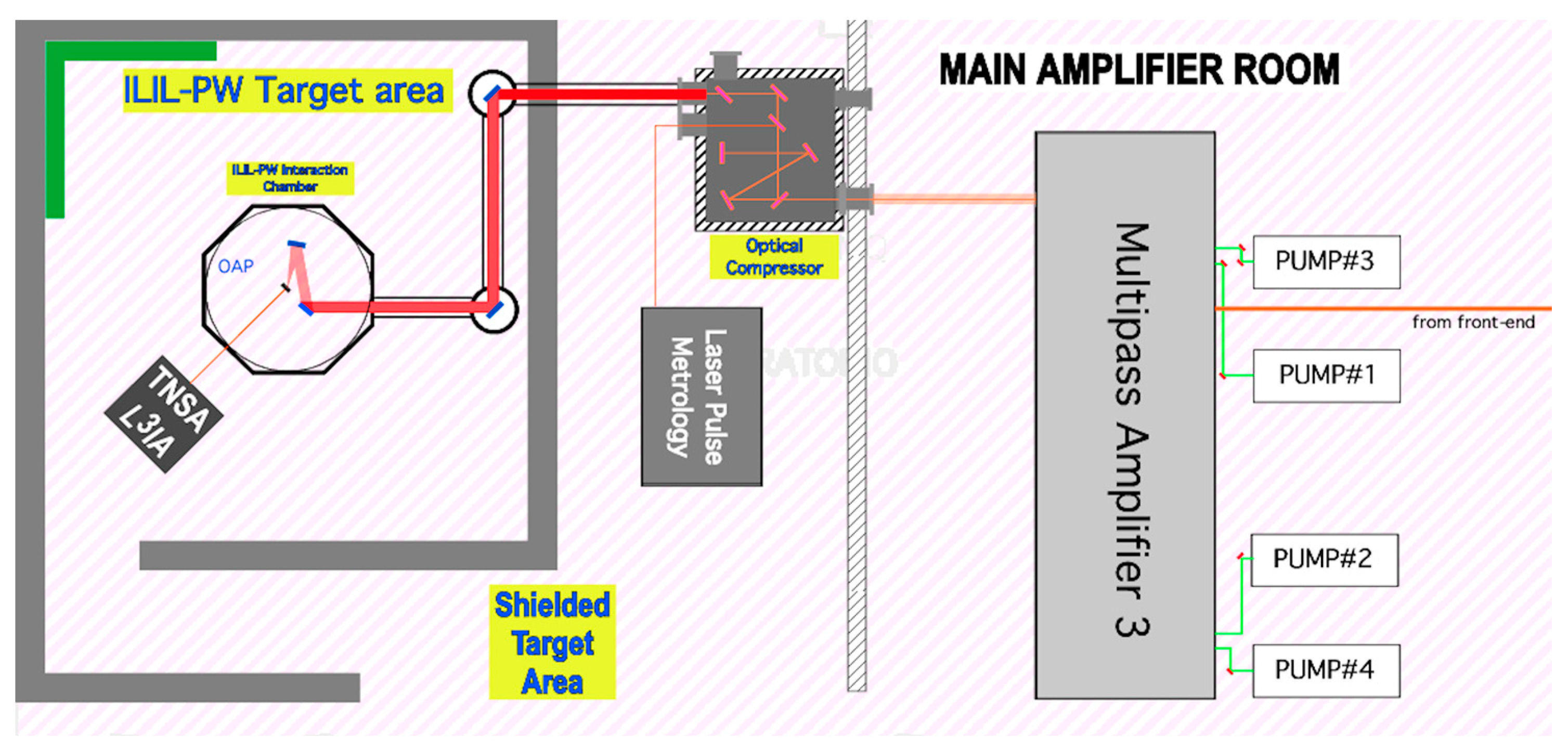
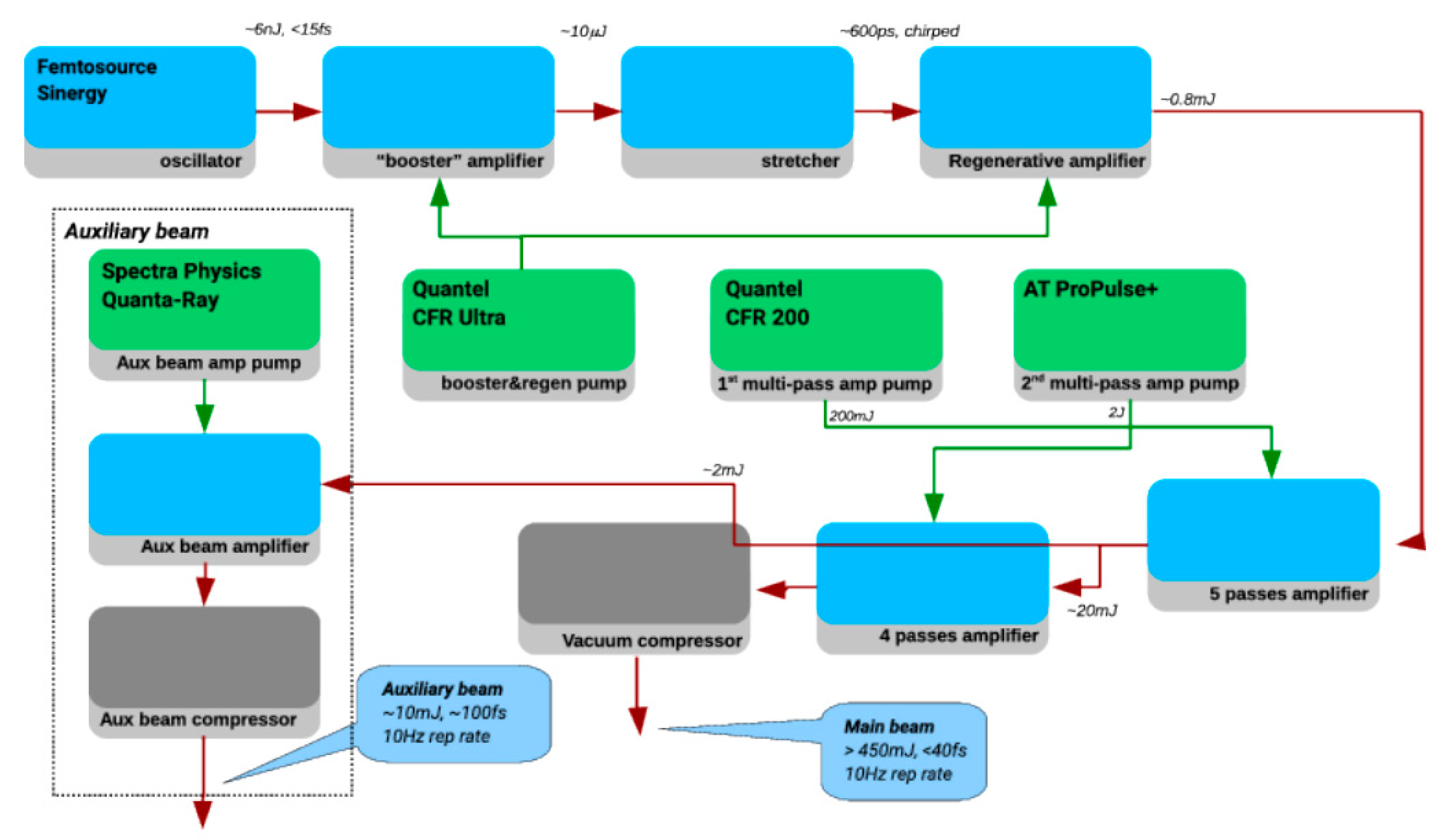
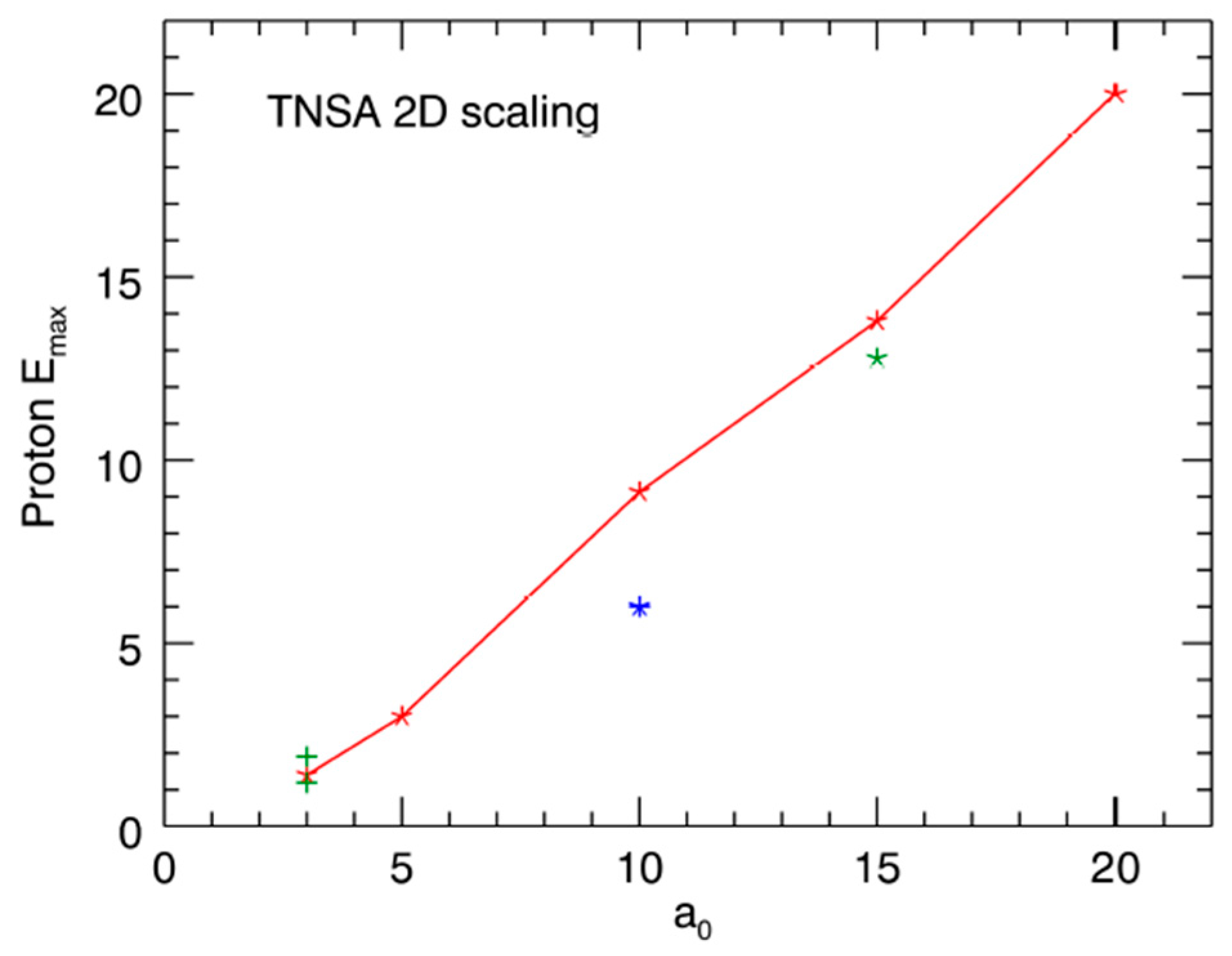
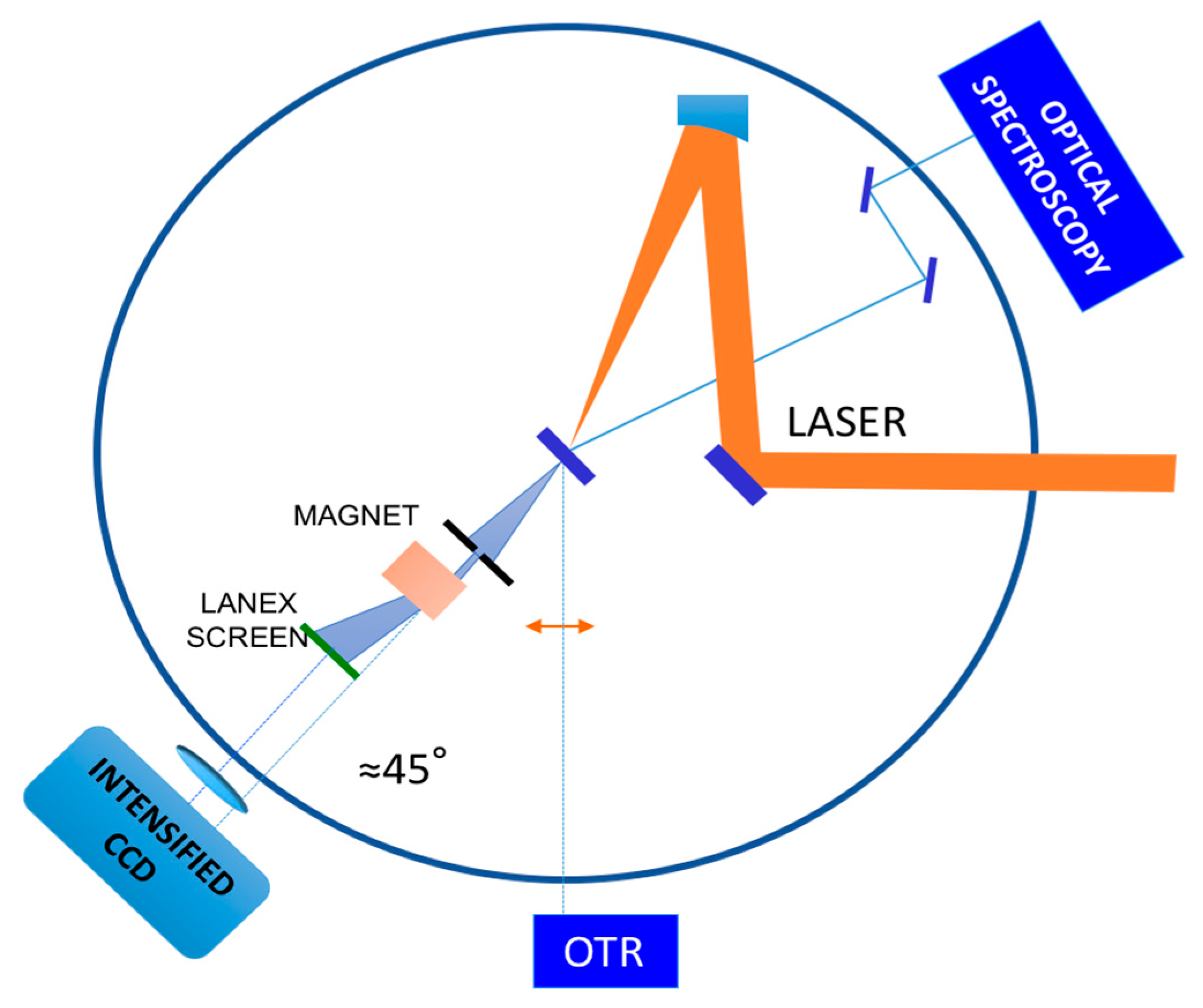
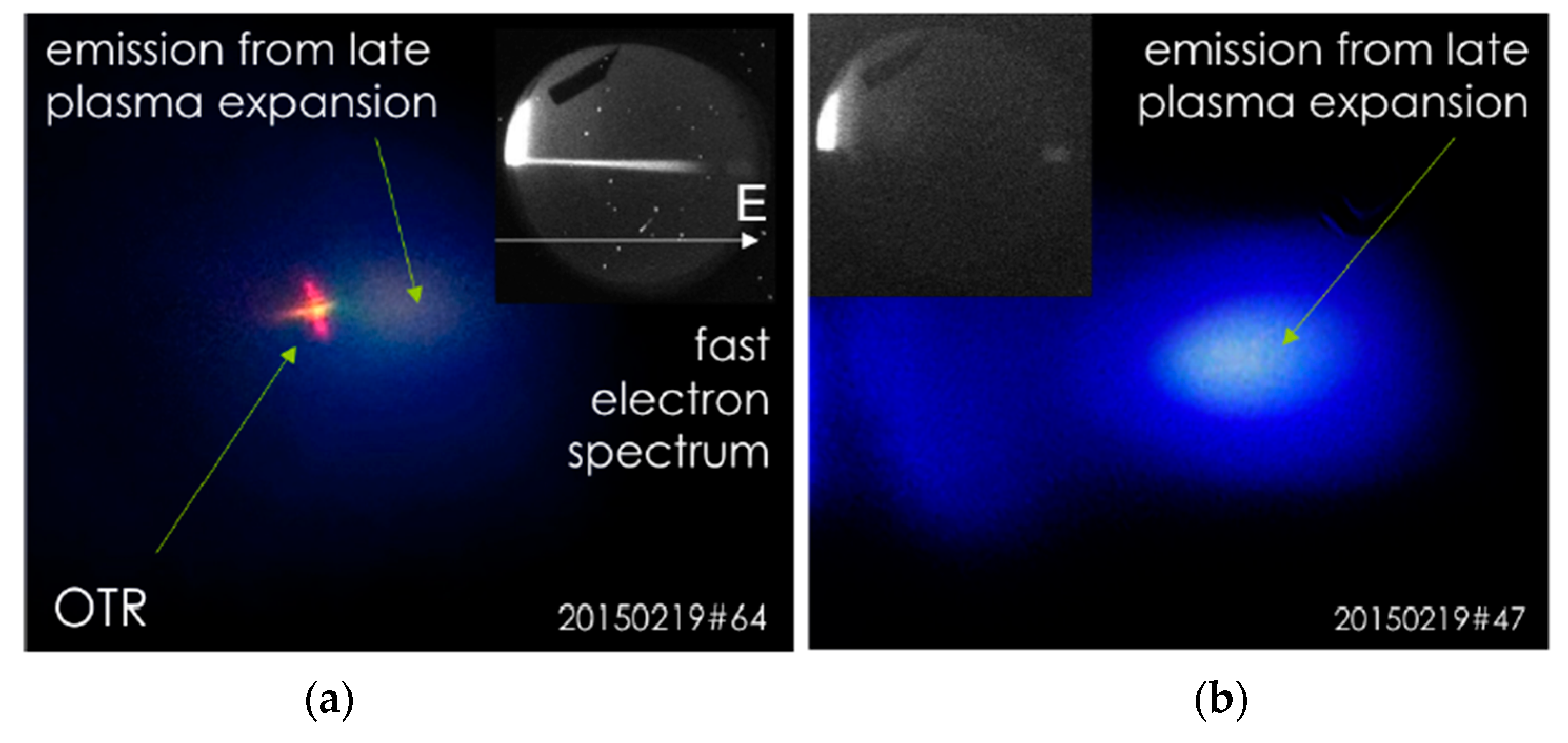
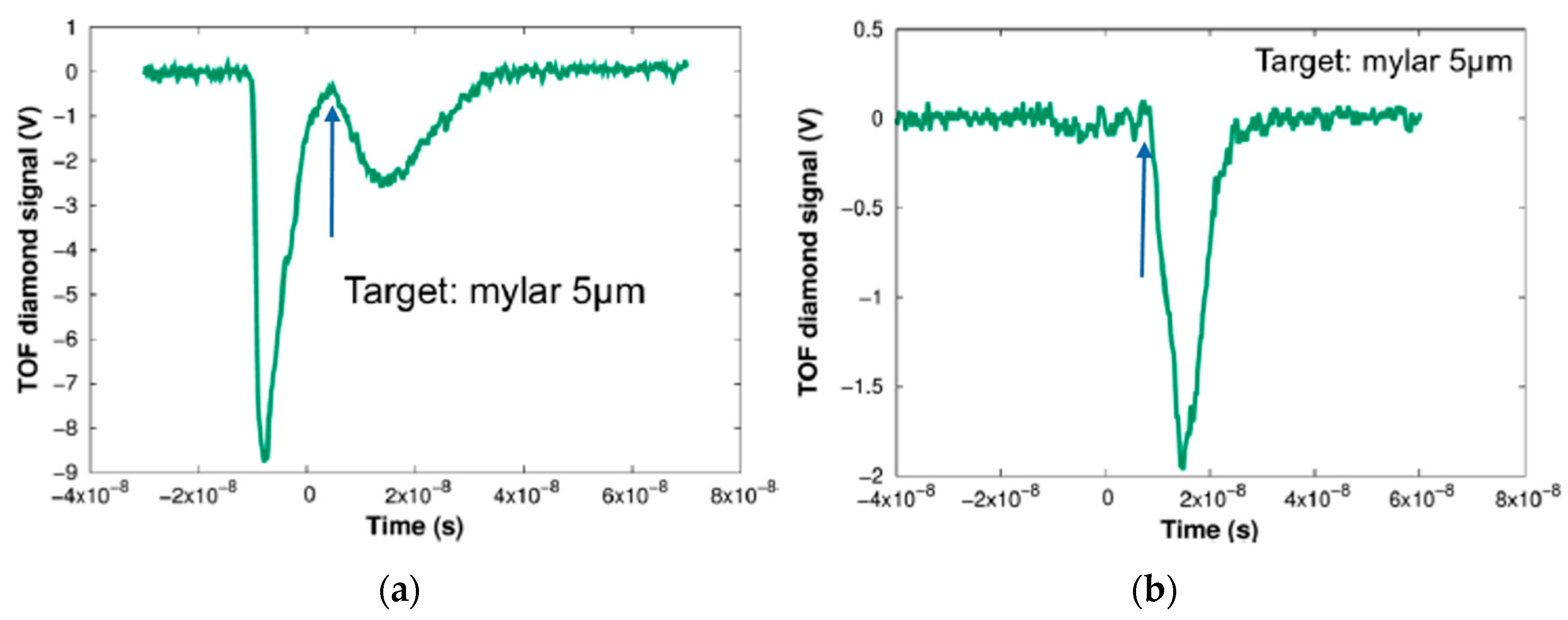
| MAIN BEAM | Front-end | 1st Phase | 2nd Phase |
|---|---|---|---|
| Wavelength (nm) | 800 | 800 | 800 |
| Pump Energy (J) | 1.8 | 12 | 24 |
| Pulse Duration (fs) | 40 | 30 | 25 |
| Energy Before Compression (J) | 0.6 | 4.7 | 7.9 |
| Energy After Compression (J) | 0.4 | >3 | >5 |
| Rep. Rate (Hz) | 10 | 1 | 2 |
| Max intensity on target (W/cm2) | 2 × 1019 | 2 × 1020 | 4 × 1020 |
| Contrast@100ps | >109 | >109 | >1010 |
| Beam Diameter (mm) | 36 | 100 | 100 |
© 2017 by the authors. Licensee MDPI, Basel, Switzerland. This article is an open access article distributed under the terms and conditions of the Creative Commons Attribution (CC BY) license (http://creativecommons.org/licenses/by/4.0/).
Share and Cite
Gizzi, L.A.; Giove, D.; Altana, C.; Brandi, F.; Cirrone, P.; Cristoforetti, G.; Fazzi, A.; Ferrara, P.; Fulgentini, L.; Koester, P.; et al. A New Line for Laser-Driven Light Ions Acceleration and Related TNSA Studies. Appl. Sci. 2017, 7, 984. https://doi.org/10.3390/app7100984
Gizzi LA, Giove D, Altana C, Brandi F, Cirrone P, Cristoforetti G, Fazzi A, Ferrara P, Fulgentini L, Koester P, et al. A New Line for Laser-Driven Light Ions Acceleration and Related TNSA Studies. Applied Sciences. 2017; 7(10):984. https://doi.org/10.3390/app7100984
Chicago/Turabian StyleGizzi, Leonida Antonio, Dario Giove, Carmen Altana, Fernando Brandi, Pablo Cirrone, Gabriele Cristoforetti, Alberto Fazzi, Paolo Ferrara, Lorenzo Fulgentini, Petra Koester, and et al. 2017. "A New Line for Laser-Driven Light Ions Acceleration and Related TNSA Studies" Applied Sciences 7, no. 10: 984. https://doi.org/10.3390/app7100984
APA StyleGizzi, L. A., Giove, D., Altana, C., Brandi, F., Cirrone, P., Cristoforetti, G., Fazzi, A., Ferrara, P., Fulgentini, L., Koester, P., Labate, L., Lanzalone, G., Londrillo, P., Mascali, D., Muoio, A., Palla, D., Schillaci, F., Sinigardi, S., Tudisco, S., & Turchetti, G. (2017). A New Line for Laser-Driven Light Ions Acceleration and Related TNSA Studies. Applied Sciences, 7(10), 984. https://doi.org/10.3390/app7100984










